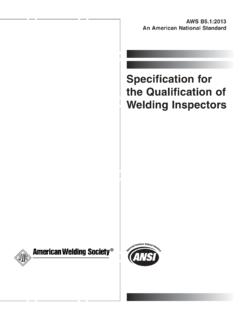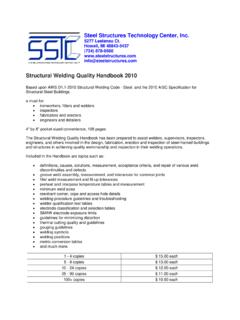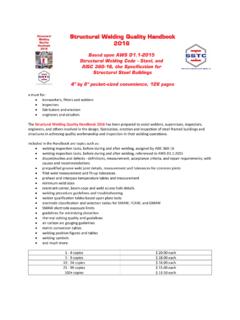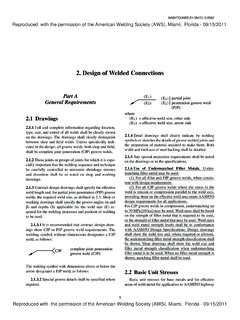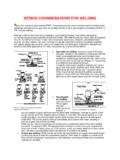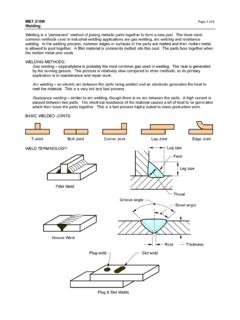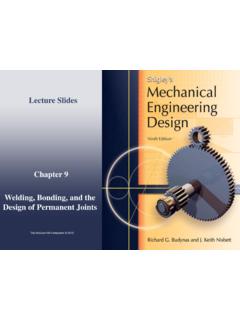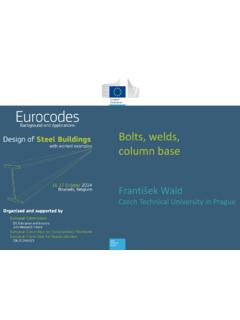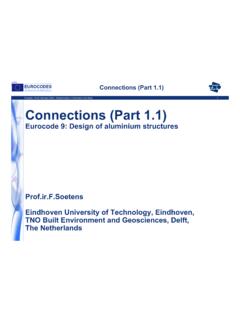Transcription of AWS Design Handbook for Calculating Fillet Weld Sizes
1 Fillet WeldSizesDesign Handbookfor CalculatingiDESIGN HANDBOOKforCALCULATINGFILLET weld SIZESL ocated, reviewed and reformatted under theAWS Product Development Committee as a servicefor quality-minded welding LeJeune Road, Miami, Florida 33126 This publication is designed to provide information in regard to the subject matter covered. It is made available with theunderstanding that the publisher is not engaged in the rendering of professional advice. Reliance upon the informationcontained in this document should not be undertaken without an independent verification of its application for a particularuse. The publisher is not responsible for loss or damage resulting from use of this publication. This document is not aconsensus standard. Users should refer to the applicable standards for their particular OF CONTENTSF oreword .. Development of Development of Fillet weld Sizes .
2 Fillet weld size Assumptions .. References .. 4 Appendix 9 Part I SteelIntercostal MemberOrdinary Strength Steel .. 10 High Strength Steel .. 11 Quenched and Tempered Steel (HY 80) .. 12 Part II Austenitic Stainless SteelIntercostal MemberAustenitic Stainless 15 Ordinary Strength Steel .. 15 High Strength Steel .. 16 Quenched and Tempered Steel (HY 80) .. 16 Part III Aluminum AlloyIntercostal MemberAluminum Alloy 5052 .. 16 Aluminum Alloy 5083 .. 18 Aluminum Alloy 5086 .. 20 Aluminum Alloy 5454 .. 21 Aluminum Alloy 5456 .. 23 LIST OF TABLESTa Material Strength Values .. Material Strength Values .. 6 LIST OF Fillet Welded Joint Loaded in Longitudinal Shear .. Fillet Welded joint Loaded in Transverse Shear .. 7 Calculating Fillet weld SizesAWS Design Handbook INTRODUCTIONS election of the correct Fillet weld size is essential for the satisfactory performance ofmany weldments in service today.
3 Fillet welds are used in virtually every industry, andwhen properly designed, provide effective and efficient designs base the size of the welds on the allowable unit loads that the weldsare expected to experience in the intended applications. For sections of different thick-nesses, the minimum Fillet size is governed by the thicker member (references 1 and 2).While this approach is conservative, the weld Sizes may not be the optimum. Filletwelds can be too large or too small and it is important to have the correct size for eachconnection. As the volume of weld metal is severely impacted by the size of the weld ,each increase in the specified Fillet weld leg length has a dramatic effect on theamount of welding larger than necessary welds will increase the amount of welding material, reducethe speed of welding, and increase the resultant distortion effects.
4 All of these willhave a negative impact on the economy of the work and the overall productivity of , too small Fillet welds will not provide the necessary performance for the weld -ment and will most likely result in repair work being alternative system for Calculating Fillet weld Sizes was presented by two research-ers through reference 3. This approach is the basis for this Handbook , and seeks toprovide a method for determining the optimum Fillet weld size . This document is not DEVELOPMENT OF CRITERIAAs the strength and ductility of Fillet welded joints varies as a function of the loadingdirection, Design equations must be developed for both longitudinal and transverseshear loads. It is also fundamentally important that the equations be applicable for awide range of base materials and filler is common for all Fillet welds to have a combination of longitudinal shear, Figure 1,and transverse shear, Figure 2.
5 For Design purposes, bending moments should besimilar to transverse loading on the Fillet welds. It is common in structural Design forthe intercostal member to be the weaker member in the joint. For these cases, thelongitudinal shear connection need only develop the ultimate shear strength of theintercostal member, and the transverse shear connection must develop the ultimatetensile of strength of the intercostal member. When welds are designed for these load-ing conditions, they are normally adequate for the variety of combinations of shearand tension loads that a member can , Fillet weld size is based upon the thickness of the weaker member andtwo mechanical properties, the ultimate tensile strength of the base material, and thelongitudinal shear strength of the weld material. The alternate method, presented inthis Handbook , requires six equations and four mechanical properties, the same twoas before, plus the ultimate shear strength of the base material and the transverseshear strength of the weld material for the intercostal member.
6 A similar set of equa-tions is required for the continuous member.






